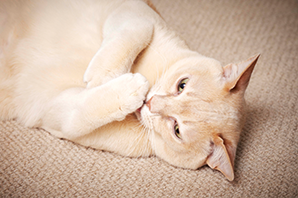Cat Health - What is cat diabetes?

Diabetes is a common condition in cats often causing serious problems if left untreated. Symptoms overlap with other diseases, making diabetes harder to diagnose.
With a healthy lifestyle, the right diet and treatment you can successfully manage the health of your diabetic cat.
Petplan takes a look into this well-known condition, giving you signs to be aware of, and treatment options for diabetes in cats…
What is cat diabetes?
Diabetes is a condition where the body is unable to either produce insulin (type one), or respond to insulin (type two), therefore losing the bodily function to balance glucose levels.
When a diabetic cat eats, they cannot ingest glucose. Instead, the glucose stays in their bloodstream, causing extremely high blood-sugar levels that can have fatal consequences.
Symptoms of cat diabetes:
Symptoms of diabetes are not immediate, and can take weeks to develop. However, there a few things to look out for if you suspect something is wrong with your cat, including:
- Weight loss and weakness – when cats cannot absorb glucose, they cannot use the calories as an energy source, so the cat will begin to break down their own body fat for energy
- Change in eating habits – a typical sign of a diabetic cat includes losing their appetite altogether, or suddenly becoming ravenous for all food
- Excessive drinking and urination – this occurs because of high blood sugar levels. The kidneys filter out glucose, along with water, which will cause your cat to urinate more frequently, subsequently becoming dehydrated and drinking more water
- Change in walking – diabetes can affect the nervous system of cats, known as diabetic neuropathy. Cats will walk with their hocks touching the ground
Diabetes in cats is diagnosed by a blood test which indicates repeatedly high glucose levels, referred to as hyperglycemia. However, high glucose levels can stem from stress so a further urine sample will be taken to determine results.
Treatment and management of cat diabetes:
The earlier diabetes is diagnosed, the better, as your vet can start treatment, such as:
- Insulin injections – cats need two injections of insulin daily. You should time low carb meals to overlap with the highest insulin activity
- Low carbohydrate diet – the chance of blood sugar peaks after a meal is reduced as fats and proteins are metabolised slower than carbs. Glucose levels will therefore not reach alarming levels. Choosing canned cat food over dry cat food is a better dietary option
- Oral tablets – the treatment of choice for cat owners who feel they cannot inject their cat
If you’re caring for a cat with diabetes, management can be hard due to their independent nature. Ensure you monitor blood glucose levels (especially for recently diagnosed cats to ensure the insulin dosage is right), take regular cat urine tests, monitor their body weight, and keep a close eye on their appetite.
If you suspect your cat could be diabetic, or own a diabetic cat and are looking for further guidance on how to care for them, be sure to speak to your vet who can advise you on all methods and alternatives.
Do you have any tips for a diabetic cat owner? Let us know in the comments below…

